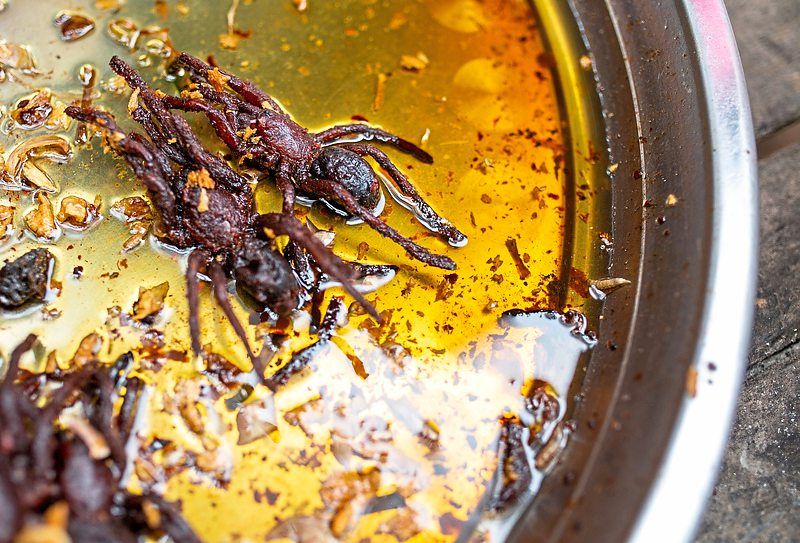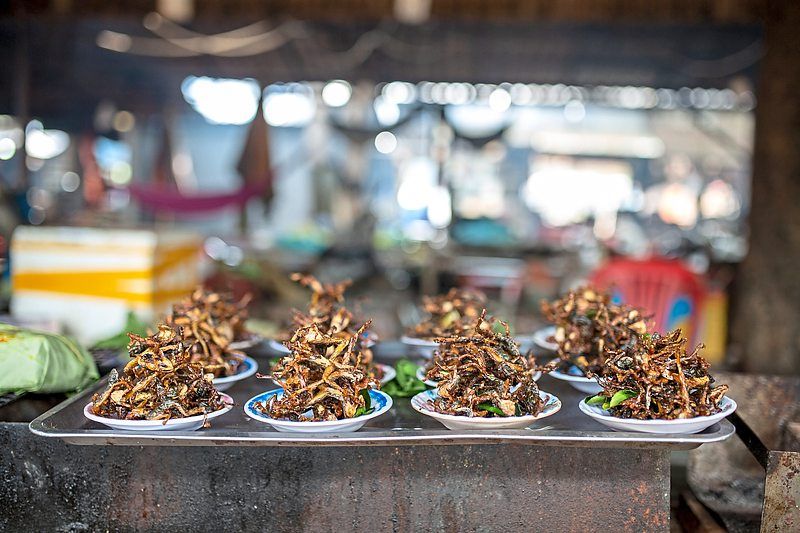Market visitors buying fried tarantulas offered at the Oudongk market. In Cambodia, fried tarantulas in spicy sauce are considered a delicacy. Photos: dpa
Oudongk market, located around one hour north of central Phnom Penh, is not your usual throng of food vendors. Alongside grilled chicken and banana pancakes, visitors can also find cooked silkworms, crispy fried crickets, vast piles of red ants complete with bone-white eggs, and mounds of fried tarantulas.
At the 50m-long market, where vendors line the base of a forested hill topped by a stupa, 25-year-old Nai Sin rests calmly behind trays containing browned crickets and a huge pile of about 50 fried tarantulas.
“I’ve been selling the bugs here for about one year,” she says. “The spiders are caught in Kampong Thom province. There are locals there who act as brokers and sell them to us... They are very delicious. No chemicals on these!”
In Kampong Thom province, about two hours north of Oudongk market, spider-catchers dig holes and use wooden sticks to snag the tarantulas, which they can catch and defang in just 30 seconds. Cricket trappers, meanwhile, can catch about 90 crickets a night, before selling them to brokers.
“I don’t make much money,” Nai Sin adds, “because they are already expensive when I buy them. On a good day, I can make around US$25 (RM110) in profit, but on other days it can be much less.”
The tarantulas, which sell for around US$1 (RM4.40), have a slightly sweet spiciness from the sauce they are cooked in and are somewhere between chewy and crunchy. Tarantulas and crickets are mainly eaten as a snack, whereas red ants can be used in pickles, stews and salads.
Tuoch Laat, another vendor who was selling red ants with eggs, said: “On normal days, I buy 2kg or 3kg to sell, but last weekend, I bought 5kg and sold out completely.”
Ma Nich, who bought a tarantula and crickets at the market, said she eats the snacks just once or twice a year.
“Crickets are my favourite,” she says. “They are crispy, easy to eat, and a little bit salty, as they are cooked in a mixture of salt, sugar and fish sauce.
“I don’t like tarantulas so much,” she adds. “The legs are really good... but the body is difficult to eat. It is not easy to swallow.”
Before the coronavirus pandemic, the sale of tarantulas, crickets and red ants in upmarket restaurants was taking off in Cambodia.
Bugs Cafe in Siem Reap, which focused on insect and arachnid-based dishes, such as deep-fried tarantulas and pan-fried scorpions, garnered positive reviews. In Phnom Penh, a social enterprise named Friends served beef stew with red ants, while Romdeng restaurant also cooked up crickets and tarantulas.
Yet the loss of tourist income amid border closures during the Covid-19 pandemic led to the establishments closing down. Eleven One is one of the only bug-selling restaurants that still exists in the capital, which also sells a beef stew with red ants. Silkworms, crickets and tarantulas, however, can still be found at street stalls in the capital and in supermarkets.
Cambodians have been eating tarantulas and other bugs for decades. The tradition stems from the hardships people endured during the brutal Khmer Rouge years in the late 1970s, when food was scarce and people resorted to eating insects to stave off hunger.
Yet nowadays, with global populations increasingly afflicted by climate change, insects and arachnids could provide an alternative source of nutritious food, especially amid rising concerns over harmful emissions from the meat industry.
According to the Food and Agriculture Organization of the United Nations (FAO), global food demand could also increase by 59% to 98% above current levels by 2050. As insects require significantly less feed than cattle, they offer a more sustainable and less resource-intensive source of food. Crucially, unlike cows, they also produce no methane.
Insects are also generally high in fibre, fat, vitamins and protein, while some Cambodians reportedly say eating tarantulas can help cure respiratory diseases.
Yet Ji Sreyneang, 37, another vendor who sells tarantulas, crickets and silkworms, said: “There are fewer and fewer tarantulas now because people catch them, and the price is getting very expensive.”
One foreigner at the market held a tarantula aloft in his hand, visibly hesitating. He finally took the plunge, ripping off a limb and chewing on it as his face contorted into a portrait of disgust.
Many in Europe and the United States are alarmed or repulsed by the idea of eating bugs, exposing the challenges of promoting insect-based cuisine.
However, Daniel, a tourist from Poland, said: “I never expected I’m going to actually like tarantulas. I decided to go adventurous regardless, purchased one for a dollar and unexpectedly devoured the whole thing in no time!... Fried spiders became one of my favourite treats.” – dpa/Chris Humphrey








